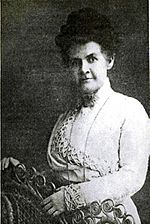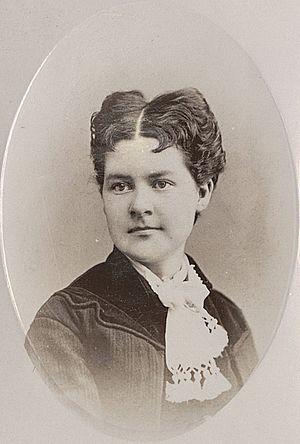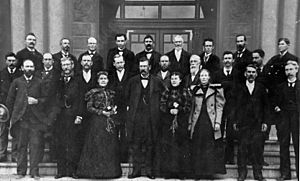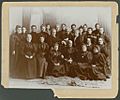Martha Hughes Cannon facts for kids
Quick facts for kids
Martha Hughes Cannon
|
|
|---|---|
 |
|
| Member of the Utah Senate from the 6th district |
|
| In office January 11, 1897 – January 13, 1901 |
|
| Preceded by | George Mousley Cannon |
| Succeeded by | Hoyt Sherman Jr. |
| Personal details | |
| Born |
Martha Maria Hughes
July 1, 1857 Llandudno, Caernarfonshire, Wales |
| Died | July 10, 1932 (aged 75) Los Angeles, California, U.S. |
| Resting place | Salt Lake City Cemetery 40°46′37″N 111°51′29″W / 40.777°N 111.858°W |
| Political party | Democratic |
| Spouse | Angus M. Cannon |
| Children | Elizabeth R.C. McCrimmon James Hughes Cannon Gwendolyn H.C. Quick |
| Parents | Peter Hughes Elizabeth Evans |
| Alma mater | University of Deseret University of Michigan University of Pennsylvania |
Martha Maria "Mattie" Hughes Cannon (born July 1, 1857 – died July 10, 1932) was a very important person in Utah's history. She was born in Wales and moved to the United States as a child. Martha became a doctor, a strong supporter of women's rights, and a leader in getting women the right to vote.
She made history on November 3, 1896, when she became the first female State Senator elected in the entire United States. What's even more interesting is that she won against her own husband, who was also running for the same job! Martha Hughes Cannon also created Utah's first health laws and helped start the state's first Board of Health.
Contents
Biography
Early Life and Moving to America
Martha Maria Hughes Cannon was born in Llandudno, Wales, on July 1, 1857. Her family, Peter and Elizabeth Hughes, joined the Church of Jesus Christ of Latter-day Saints. They decided to move to the United States with their two daughters, Mary Elizabeth and Martha.
They left Liverpool, England, in March 1860 and arrived in New York City in May 1860. Martha's father was very sick, and her mother gave birth to another child, Annie Lloyd, in New York. The family stayed in New York to earn money for their journey to Utah.
In 1861, they joined a group traveling west. Sadly, Martha's baby sister, Annie, died during the journey. Just three days after they arrived in Salt Lake City, Utah, on September 17, 1861, Martha's father also passed away. Her mother, Elizabeth, was left alone with two young daughters. Later, Elizabeth married James Patten Paul, who encouraged Martha to follow her dream of becoming a doctor.
Education and Medical Career
When Martha was fourteen, she worked as a school teacher for a year. Later, she learned how to set type for printing. She worked for the Deseret News and then for the Women's Exponent, a newspaper for women in Salt Lake City. There, she met important women like Emmeline B. Wells and Eliza R. Snow, who encouraged her to become a doctor.
In 1873, Brigham Young, a leader of the LDS Church, encouraged women to become doctors. That same year, at age sixteen, Martha started studying at the University of Deseret (now the University of Utah). She worked during the day and took classes at night. She earned a degree in chemistry in 1878.
After that, Martha was chosen by church leaders to study medicine. She went to the University of Michigan in 1878 and graduated on her 23rd birthday in 1880. She then moved to Philadelphia to take more advanced medical courses at the University of Pennsylvania. She was the only woman among 75 students. She also studied public speaking. By age 25, Martha Hughes had earned four different degrees!
Martha returned to Salt Lake City and opened her own medical office. In 1882, she became the main doctor at the new Deseret Hospital. She also started training classes for nurses and taught about childbirth.
Personal Life and Time in Europe
While working at Deseret Hospital, Martha met Angus Munn Cannon, who was a leader in the LDS Church. In 1884, Martha married Angus in a religious ceremony. This was a "plural marriage," meaning Angus had other wives. At that time, this type of marriage was against the law in the United States, and people who practiced it could go to jail.
To avoid having to testify in court against her husband and others, Martha went into hiding. She found out she was pregnant while Angus was in jail. She had her first child, Elizabeth Rachel, while still in hiding. In 1886, Martha decided to travel to Europe to stay with relatives and avoid legal trouble.
She traveled with her baby to England. Her letters to Angus showed she missed him and was sometimes jealous of his other wives. After about a year, Martha returned to Utah in 1887. Angus met her and Elizabeth when they arrived.
Fighting for Women's Right to Vote
While Martha was in Europe, a new law called the Edmunds–Tucker Act was passed. This law took away the right to vote from women in Utah, even though they had been voting since 1870. When Martha returned, she became a leader in the Utah Women's Suffrage Association. She gave speeches in Utah and attended conferences with famous women's rights leaders like Susan B. Anthony and Elizabeth Cady Stanton.
Martha spoke at the World's Columbian Exposition in 1893 and reported to a committee in Washington D.C. about women's voting rights in Utah. She believed that women in plural marriages could have more freedom because their husbands might be away visiting other wives, giving them more time for themselves.
Political Career
After 1888, Martha continued her medical practice in Salt Lake City. In 1896, Utah became a state, and women in Utah got their right to vote back. Martha ran for State Senator from Salt Lake County as a Democrat. Her husband, Angus, was also running for the same position as a Republican.
On November 3, 1896, Martha Hughes Cannon made history by becoming the first woman elected as a state senator in the United States. She received more votes than her husband. They both said their relationship was fine despite the election results.
In her first month as a senator, Martha introduced three important bills:
- An Act Providing for Compulsory Education of Deaf, Dumb, and Blind Citizens: This law helped make sure children who were deaf, blind, or couldn't speak received an education. Because of this bill, she was appointed to the board of directors for the school for the Deaf and Dumb.
- An Act to Protect the Health of Women and Girl Employees: This bill required employers to provide places for female employees to rest when they weren't working. This helped prevent them from becoming too tired.
- An Act Creating a State Board of Health and Defining its Duties: This bill created Utah's first State Board of Health, which was very important for public health.
Martha also supported Utah's first pure food law. She fought to keep the State Board of Public Examiners, which checked if doctors and midwives were properly qualified. As a doctor herself, she knew how important it was to protect patients from untrained people.
In 1898, Martha spoke at the 50th-year celebration of the Seneca Falls Convention in Washington D.C., which was a major event for women's rights. She also told the U.S. House Committee on the Judiciary about the positive effects of women voting in Utah. Twenty-two years later, women's right to vote was added to the United States Constitution as the 19th Amendment.
During her second term, Martha worked on rules for dealing with contagious diseases. She was appointed to the Board of Health and tried to make sure children were vaccinated to prevent disease outbreaks. She also helped remove shared drinking cups from water fountains in Salt Lake Valley to stop the spread of germs.
Martha had her third child near the end of her term and decided not to run for office again. The Deseret News newspaper praised her, saying her quick thinking and knowledge made her a strong representative for women in politics.
Later Years and Legacy
After leaving the legislature, Martha continued to serve on the Utah Board of Health and the board for the Utah State School for the Deaf and Dumb. In 1904, she moved to California with her children for health reasons. She became the vice president of the National Congress of Tuberculosis.
Martha Hughes Cannon passed away in Los Angeles, California, on July 10, 1932. She was buried in the Salt Lake City Cemetery next to her husband.
Martha Hughes Cannon is remembered as a pioneer for women's rights and public health.
- In 1986, the new Utah Department of Health building in Salt Lake City was named the Martha Hughes Cannon Health Building.
- An eight-foot-tall bronze statue of her stands in the Utah State Senate building on Utah Capitol Hill.
- Since 1990, people in Utah have asked the U.S. Postal Service to create a postage stamp in her honor.
- In 2015, lawmakers formed the Martha Hughes Cannon caucus to encourage more women in Utah to get involved in government.
- In 2018, the Utah State Legislature voted to send a statue of Martha Hughes Cannon to the United States Capitol in 2020, where it would represent Utah in the National Statuary Hall.
Images for kids
See also
 In Spanish: Martha Hughes Cannon para niños
In Spanish: Martha Hughes Cannon para niños




